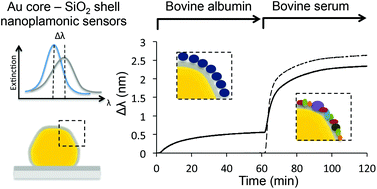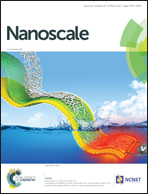Real-time in situ analysis of biocorona formation and evolution on silica nanoparticles in defined and complex biological environments†
Abstract
Biomolecules such as proteins immediately adsorb on the surface of nanoparticles upon their exposure to a biological environment. The formed adlayer is commonly referred to as biomolecule corona (biocorona) and defines the biological activity and toxicity of the nanoparticle. Therefore, it is essential to understand in detail the biocorona formation process, and how it is governed by parameters like composition of the biological environment, and nanoparticle size, shape and faceting. Here we present a detailed equilibrium and real time in situ study of biocorona formation at SiO2-nanoparticle surfaces upon exposure to defined (BSA, IgG) and complex (bovine serum, IgG depleted bovine serum) biological samples. We use both nanofabricated surface-associated Au core–SiO2 shell nanoparticles (faceted, d = 92–167 nm) with integrated nanoplasmonic sensing function and dispersed SiO2 nanoparticles (using DLS and SDS-PAGE). The results show that preadsorbed BSA or IgG are exchanged for other proteins when exposed to bovine serum. In addition, the results show that IgG forms a biocorona with different properties at curved (edge) and flat (facet) SiO2-nanoparticle surfaces. Our study paves the way for further real time in situ investigations of the biocorona formation and evolution kinetics, as well as the role of molecular orientation in biocorona formation, on nanoparticles with surface faceting.



 Please wait while we load your content...
Please wait while we load your content...